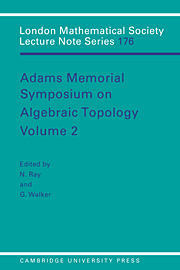Book contents
- Frontmatter
- Contents
- Preface
- Contents of Volume 1
- Programme of one-hour invited lectures
- Programme of contributed lectures
- Programme of Posters
- Participants in the Symposium
- Addresses of Contributors
- 1 Progress report on the telescope conjecture
- 2 On K*-local stable homotopy theory
- 3 Detruncating Morava K-theory
- 4 On the p-adic interpolation of stable homotopy groups
- 5 Some remarks on υ1 -periodic homotopy groups
- 6 The unstable Novikov spectral sequence for Sp(n), and the power series sinh−1(x)
- 7 Unstable Adams spectral sequence charts
- 8 On a certain localization of the stable homotopy of the space XΓ
- 9 Cooperations in elliptic homology
- 10 Completions of G-spectra at ideals of the Burnside ring
- 11 Theorems of Poisson, Euler and Bernouilli on the Adams spectral sequence
- 12 Algebras over the Steenrod algebra and finite H-spaces
- 13 The boundedness conjecture for the action of the Steenrod algebra on polynomials
- 14 Representations of the homology of BV and the Steenrod algebra I
- 15 Generic representation theory and Lannes' T-functor
- 16 Some chromatic phenomena in the homotopy of MSp
- 17 On a conjecture of Mahowald concerning bordism with singularities
- 18 Topological gravity and algebraic topology
1 - Progress report on the telescope conjecture
Published online by Cambridge University Press: 18 January 2010
- Frontmatter
- Contents
- Preface
- Contents of Volume 1
- Programme of one-hour invited lectures
- Programme of contributed lectures
- Programme of Posters
- Participants in the Symposium
- Addresses of Contributors
- 1 Progress report on the telescope conjecture
- 2 On K*-local stable homotopy theory
- 3 Detruncating Morava K-theory
- 4 On the p-adic interpolation of stable homotopy groups
- 5 Some remarks on υ1 -periodic homotopy groups
- 6 The unstable Novikov spectral sequence for Sp(n), and the power series sinh−1(x)
- 7 Unstable Adams spectral sequence charts
- 8 On a certain localization of the stable homotopy of the space XΓ
- 9 Cooperations in elliptic homology
- 10 Completions of G-spectra at ideals of the Burnside ring
- 11 Theorems of Poisson, Euler and Bernouilli on the Adams spectral sequence
- 12 Algebras over the Steenrod algebra and finite H-spaces
- 13 The boundedness conjecture for the action of the Steenrod algebra on polynomials
- 14 Representations of the homology of BV and the Steenrod algebra I
- 15 Generic representation theory and Lannes' T-functor
- 16 Some chromatic phenomena in the homotopy of MSp
- 17 On a conjecture of Mahowald concerning bordism with singularities
- 18 Topological gravity and algebraic topology
Summary
The Telescope Conjecture (made public in a lecture at Northwestern University in 1977) says that the υn–periodic homotopy of a finite complex of type n has a nice algebraic description. It also gives an explicit description of certain Bousfield localizations. In this paper we outline a proof that it is false for n = 2 and p ≥ 5. A more detailed account of this work will appear in [Rav]. In view of this result, there is no longer any reason to think it is true for larger values of n or smaller primes p.
In Section 1 we will give some background surrounding the conjecture. In Section 2 we outline Miller's proof of it for the case n = 1 and p > 2. This includes a discussion of the localized Adams spectral sequence. In Section 3 we describe the difficulties in generalizing Miller's proof to the case n = 2 We end that section by stating a theorem (3.5) about some differentials in the Adams spectral sequence, which we prove in Section 4. This material is new; I stated the theorem in my lecture at the conference, but said nothing about its proof. In Section 5 we construct the parametrized Adams spectral sequence, which gives us a way of interpolating between the Adams spectral sequence and the Adams–Novikov spectral sequence. We need this new machinery to use Theorem 3.5 to disprove the Telescope Conjecture. This argument is sketched in Section 6.
- Type
- Chapter
- Information
- Adams Memorial Symposium on Algebraic Topology , pp. 1 - 22Publisher: Cambridge University PressPrint publication year: 1992
- 7
- Cited by



